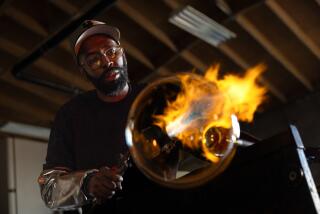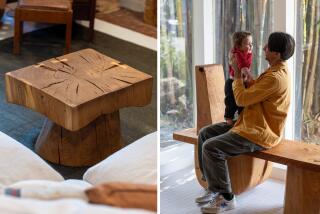He Who Lives in Glass House Displays Art in Louvre : Glassblowing: Seattle manâs work can be found at a variety of U.S. embassies, in corporate headquarters, and more than 80 museums around the world, including the Metropolitan, Louvre and Smithsonian.
SEATTLE â One windowsill is lined with doll-house furniture, another with 16 dog figurines. Baskets woven by Pacific Northwest Indians jam a ledge below the bedroom loft.
Hanging overhead in a couple of rooms are old wooden racing shells, much like the ones once made from the finest Western red cedar by George and Stan Pocock for rowing crews around the world.
What draws attention to the Pococksâ old corrugated-metal boathouse today is glass--more than $1 million worth of dazzling chandeliers and delicate sculptures, brilliant sunbursts and shimmering pastels, room after room replete with the realized visions of Dale Chihuly, 52.
It is a vision reduced to one eye by the shards from a shattered windshield in a car wreck 17 years ago.
Lacking the depth of field to manipulate the five-foot blowpipe, Chihuly went from a glass art prodigy to a master artist whose glassblowing teams render his paintings and drawings in molten silica.
More than any American since Louis Comfort Tiffany became the leading American proponent of Art Nouveau a century ago, Chihuly has focused the spotlight of the art world on glass.
In 1986 Chihuly became the third American to be given a solo show at the Palais du Louvre in Paris.
Last fall, in a ceremony at the University of North Carolina at Wilmington, Chihuly was honored as the first U.S. National Living Treasure. The selection, based on a cultural tradition in Japan, was made by 42 judges from people nominated by the nationâs governors for creativity and leadership in their fields.
âMy interest is with transparency and illusion and magic, beauty,â Chihuly said. âWe donât worry about what we make. We make what we want, and then thatâs what the galleries show.
âWhat is art? I donât know what art is, but itâs certainly something that we elevate to something very special, I guess, and I think that the best of almost anything is an art. . . . âIâm not saying that mine is the best glass, but people look for the best in all areas,â he said. âI donât really care whether they call it art or craft, it really doesnât make any difference to me, but I do like the fact that people want to see it.â
That they do.
At the Seattle Art Museum last year, a 10-week Chihuly retrospective covering 9,000 square feet drew 163,632 visitors. By comparison, the eight-week William S. Paley collection of Impressionist paintings drew 113,660.
Chihuly was given the largest glass art show in history last December at the Taipei Fine Arts Museum in Taiwan. He also had major exhibits at the Detroit Institute of Arts, Honolulu Academy of Arts, American Craft Museum in New York and Contemporary Arts Center in Cincinnati over the last year.
His work can be found at U.S. embassies in Paris and London; the National Geographic Society in Washington; IBM Corp. in New York, and more than 80 museums worldwide, including the Metropolitan, Louvre and Smithsonian.
Prices range from $1,500 for small works blown for a museum fund-raiser to $30,000 for 10-piece compositions and $250,000 for chandeliers with scores of pieces.
Chihuly draws inspiration from the Far West to the Far East.
âPilchuck Baskets,â a series named for the glass art school he founded in 1971, was based on the Indian woven baskets he discovered misshapen from years of storage at the Washington State Historical Society in Tacoma. The Indian baskets now rest on a ledge below the loft he shares with his girlfriend, choreographer Petra Franklin.
Then there are the spectacular flower blossoms in âPersiansâ; austere sinuous forms derived from Japanese flower arranging in âIkebanaâ; rococo vases, many featuring cherubic figurines called putti, in âVenetiansâ; and the bowl âMacchia,â Italian for spotted or speckled.
Married once and divorced, the son of a butcher and meat cutters union organizer, Chihuly said his interest in glass may have begun at Sherman Elementary School in Tacoma.
âI think playing marbles hooked me on it back in the fifth grade. I was an ace marble shooter,â he said. âI used to take so many marbles Iâd sell them back to people the next day.â
When Chihuly was 15, his 21-year-old brother died in a plane crash. The next year his father died of a heart attack.
âThat was tough,â he said. âIt was very tough on both me and my mom. She never remarried, and so in many ways it put me a lot closer to my mother.â
Depressed, not wanting to go to college, he enrolled at the University of Puget Sound in Tacoma in 1960 at his motherâs insistence. Still living at home, he remodeled the basement into a recreation room.
âI thought, âHere, Iâve found my calling, a really hotshot designer,â so I decided to go to the University of Washington to study interior design,â he said.
In 1962, halfway through the school year, he got restless and sailed to Italy to study art in Florence.
Unable to speak much Italian, he became depressed, took off traveling and wound up at the Lehav Kibbutz, or collective farm, in Israel.
Under the intense heat of the Negev desert, inspired by the idealism and character of the kibbutzniks, his spirits were revived in a month.
He returned to school, graduated with honors in 1965 and was hired by John Graham Associates, the architectural firm that had designed the Space Needle for the worldâs fair in Seattle in 1962.
That didnât last long.
Living in the basement of a union organizer who had been friends with his father, Chihuly was introduced to glassblowing by Russell Day, an instructor at Everett Community College.
One day in 1965, he got a small furnace, some glass and a length of pipe.
âI get a bubble first out. Boom! Iâm flipped out. I say, âThis is for me. Iâm going to be a glassblower,â â Chihuly said.
Chihuly baited hooks on a salmon trawler in Alaska and used his earnings to attend Harvey Littletonâs pioneering glass program at the University of Wisconsin in 1966.
The next year he enrolled at the Rhode Island School of Design, won the Louis Comfort Tiffany Foundation Award, earned a master of fine arts degree in sculpture and was awarded a Fulbright Fellowship to study in Venice, where glassblowing has enjoyed fine-art status on the island of Murano since the late 13th Century.
Lacking Muranese glassblowing skills, Chihuly watched intently, learning techniques that were closely kept secrets and the type of teamwork critical to meeting the physical demands of glasswork.
On his return in 1969, he taught for a summer at Haystack Mountain School on Deer Isle, Me., then started a glassmaking department at the Rhode Island School of Design.
In 1971 Chihuly obtained a $2,000 grant to open an art school devoted solely to glass. The first 16 students arrived at Pilchuck Glass School on an idyllic hillside about 40 miles north of Seattle. They began by building a hot shop under a tarpaulin. Two weeks later, glassblowing began.
Today the school has an annual budget exceeding $1 million, 30 faculty members, 10 master glassblowers, 10 artists in residence and as many as 250 students with 50 teaching assistants in the summer.
Still, Chihuly said, âI really didnât sell any glass.â
Five years later he was on a lecture tour in England with Seaver Leslie, a friend and painter. Seaver was at the wheel as they approached a rotary intersection in the Gloucestershire countryside west of London during a nighttime storm.
âWe had a head-on collision, and I was nearly killed,â Chihuly said.
Dozens of stitches were needed to close the cuts from flying glass. Chihulyâs left eye was permanently dilated and unable to focus.
Shortly afterward, Henry Geldzahler, then head of the contemporary art department of the Metropolitan Museum of Art in New York, expressed interest in buying a piece. Chihuly took some of his works to New York and the curator bought three.
âI remember it as being the single most important thing in my career,â Chihuly said. âIt was more important to me than showing in the Louvre.â
When he tried to return to glassblowing, though, he was unable to gauge distances among his blowtorch-wielding assistants in the hot shop.
By 1980 he had put down the blowpipe for the last time, and begun his rise to international recognition.
âIn a way, you know, that even got to be perhaps a lucky thing for me,â Chihuly said. âIt allowed my work to get much more complicated because I could direct a team.
âBack when I was walking around a shop, I couldnât. Being a gaffer (blower) was a lot of pressure on me.
âThereâs disadvantages, certainly, advantages also. It certainly allows you to think about other things than just always how to make the form.â
More to Read
The biggest entertainment stories
Get our big stories about Hollywood, film, television, music, arts, culture and more right in your inbox as soon as they publish.
You may occasionally receive promotional content from the Los Angeles Times.










